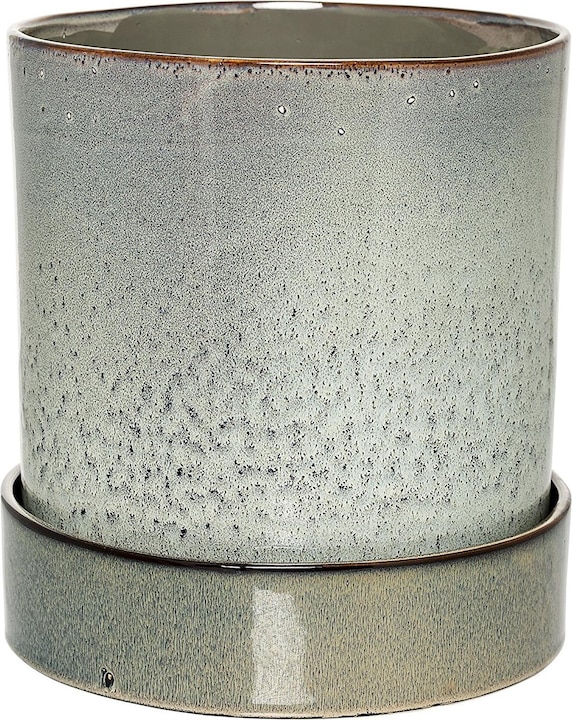

Exoticism on our terraces
The cultivation of plants from distant lands began in the early Middle Ages. The courts of European sovereigns were particularly fond of citrus plants, which were always green and covered with fruit and flowers, a sign of prosperity.

In mythology, citrus fruits are symbols of longevity and prosperity. In the 16th and 17th centuries, they were grown in orangeries, places dedicated to them, then in special greenhouses from the 18th century. These greenhouses, used in botanical gardens, are now home to exotic flowers. Orangeries were used to grow precious exotic plants that were unaccustomed to our variations in temperature and would not otherwise have survived. They can be compared to our contemporary conservatories.

The exotic plants that will populate our terraces, balconies and gardens go on sale in garden centres from the end of April. Given the large number of varieties on offer, it's best to take the time to visit a gartencenter, landscaping shop or florist for advice.
Your plants should be brought out of their winter shelter and roused from their slumber as early as April, or even mid-March, depending on the weather. For some years now, many gardeners have been offering a wintering service for exotic plants. This is a very practical solution, as we don't always have the space to store them during the cold season.
The following tips will show you how to care for your plants and what you need to pay attention to in order to enjoy your plants for a long time.
Rematting and repotting exotic plants
Rematting
The basic rule is to cut back dried-out shoots by around 20-30 cm. The larger the plant, the more you'll need to cut back. It may also need a little pruning, depending on its age. It's best to prune back the bare shoots at the base, so that the plant can grow back "from the inside". In this video (in German), I show you how to do this with an old sage plant. The process is the same for exotic plants. It can be repeated without problem over several years when they lignify, i.e. when the trunk and branches lose their suppleness and turn into wood.

Pot
Pot your plants directly after you have pulled them back. Use fresh soil to help them recover and become bushy again. If the root ball and soil are already very large, you can reduce them slightly. Work the roots and pieces of soil in a balanced way.
Substrates and fertilisers
As a general rule:
- For palms: use palm potting soil intended for outdoor use. Be careful not to use this type of potting soil for your indoor plants. It is far too light (it contains too little clay). If you don't have potting soil for palms, potting soil for exotic plants is also suitable, as it contains a lot of clay and loam. Palms have completely different needs to geraniums, for example. Use a palm fertiliser or an exotic plant fertiliser.
- Citrus trees such as orange trees require a potting soil and fertiliser specially designed for their needs. This type of potting soil contains clay and retains water better. Be careful to remove any standing water from the pot before pouring in the fertiliser, and stick to the recommended doses, otherwise you risk "burning" the plant.
- For oleander, bougainvillea and similar plants, use potting soil for exotic plants and fertiliser intended for flowering plants (geraniums and balcony plants).
Pots designed for outdoor spaces
In addition to its aesthetic aspect, the pot plays an important role in the growth of exotic plants. It must be adapted to terraces. There are various materials:
- Baked clay
- Sandstone (Asian pot)
- Wood
- Oak (barrel)
- Metal
- Fibrocement
- Plastic

I recommend terracotta or stoneware pots depending on how much water the plant needs. Oak barrels with handles are also great for bulky exotic plants. Their shape makes them stable and easy to transport. Metal pots can also be very elegant.
Some plastic pots are certainly beautiful and of excellent quality, but I would only recommend them for plants that need a lot of water. This is because the water doesn't evaporate as well as it does in terracotta pots, which isn't suitable for plants that need drought. Terracotta and stoneware pots are also heavier and therefore very stable. They are less likely to tip over in bad weather. Lantanas and fuchsias in pyramid or stem form are particularly fragile and usually die if they break. A less conical pot shape will help prevent this. Don't forget to pierce plastic pots so that water can drain.
Acclimatisation
In spring, exotic plants absolutely must be acclimatised. Only take them out when temperatures have risen above zero. Place them in a warm spot sheltered from the wind for the first two to three weeks. Avoid direct exposure to sunlight, as it will burn the leaves.
Buying exotic plants
Exotic plants are generally a long-term purchase, so get a quality plant. Many new varieties have appeared in shops in recent years.
Answer the following questions before you shop.
- Where will you place the plants?
- Is the location warm and sunny (afternoon sun) or cool and shady (morning sun)?
- Are the plants protected by an awning or placed against a wall and bathed in sunlight?
- Will the plants grow straight up or climb, helped by a support?
- How tall can they grow?
I've put together a list of classic Mediterranean plants that grow very well in our climates. Given the multitude of plants available, this list is of course not exhaustive.
The bougainvillea
It loves the sun and the warmth of south-facing walls. The warmer and sunnier its location, the better. Give it regular fertiliser and don't let it dry out too much, even though it tolerates drought well.

Oleander (nerium oleander)
Oleander needs light, warmth and regular watering and fertiliser to thrive despite our fluctuating temperatures.

The date (palm) tree (phoenix canariensis)
To grow quickly, the Canary date palm needs warmth and frequent watering. It survives short periods of frost, if the temperature does not fall below -6 degrees Celsius.

Citrus fruits
They are native to the tropical and subtropical regions of South-East Asia. These trees and shrubs never lose their leaves. Their white flowers emanate a delicious fragrance that grows more intense at dusk.

Passionflower
Passiflora is a magnificent climbing plant with flowers that are as voluminous as they are fascinating. When given enough sun, warmth and fertiliser, it flowers for a long time and requires little maintenance.

Caring for exotic plants
A regular supply of water and fertiliser is essential. Be sure to water plants in the morning or evening. Don't do it at midday, as the drops of water reflect the sun's rays like magnifying glasses and can burn the plants. Cold water also damages certain sensitive plants. Water the roots before adding fertiliser, so they don't get burnt! Many exotic plants like low calcium water.
Pests and diseases
Exotic plants are unfortunately not spared from parasites and diseases. Among the most common are:
Red spiders
Red spider mites appear in hot, dry weather. Affected leaves become translucent. Small spider webs are typical signs of an infestation. When they first appear, or if there are only a few spiders, I recommend that you hose the plant down regularly. But this is not enough in the most serious cases. If the plant is in a conservatory, you can also use beneficial insects. Find out more in a forthcoming article.
Mealybugs
Scales are particularly fond of hard-leaved plants such as oleander, citrus or sauce laurel. Their protective carapace makes them difficult to eliminate. Among other things, there are natural sprays based on essential oils that combat these pests very effectively.
Aphids and fumagine
Aphids like young leafy shoots and flower buds. When infested, a sticky substance called honeydew appears on the tops of the leaves. The insects live mainly under leaves and stems. In the event of a serious infestation, they will also inhabit the tops of the leaves. The presence of aphids is generally not serious, but it is unsightly. Severe cases can cause fumagine. This is characterised by a black, soot-like deposit that can be wiped off with a cloth. If your plant is affected, clean it and wipe it gently. Spray all over with an aphid repellent that won't harm beneficial insects. Repeat the operation after 10 to 14 days.
Oleander canker
Oleander is one of the most popular Mediterranean plants. It is relatively easy to care for in summer, but needs a certain amount of water and nutrients. In winter, the task becomes more difficult, as it is often affected by oleander canker, a bacterial disease. There are no biological or chemical treatments available. The tips of the shoots turn black and eventually necrose. The only way to stop the spread of oleander canker is to remove the diseased shoots. It is assumed that all European oleanders are infected with this bacterium, but resistant and healthy plants are less affected.

Wintering exotic plants
I will devote another article to overwintering exotic plants indoors or outdoors, which is done from late autumn (September/October).
For now, I wish you much pleasure when buying and repotting your exotic plants. Please don't hesitate to give me feedback!
These products might be useful to you








Hauert Citrus and palm trees
0.35 kg, 0.25 l


You might also be interested in these items
I discovered my love for gardening very early on and later turned my passion into my profession. For a few years now, I’ve been regularly writing blog posts and publishing articles in the HomeGardening section of myPfadFinder.com. This is where I give readers tips and tricks on gardens and balconies and present my latest gardening videos.
Find out more about me here: <a href="http://www.andreas-homegardening.com/" target="_blank">www.andreas-homegardening.com</a>
